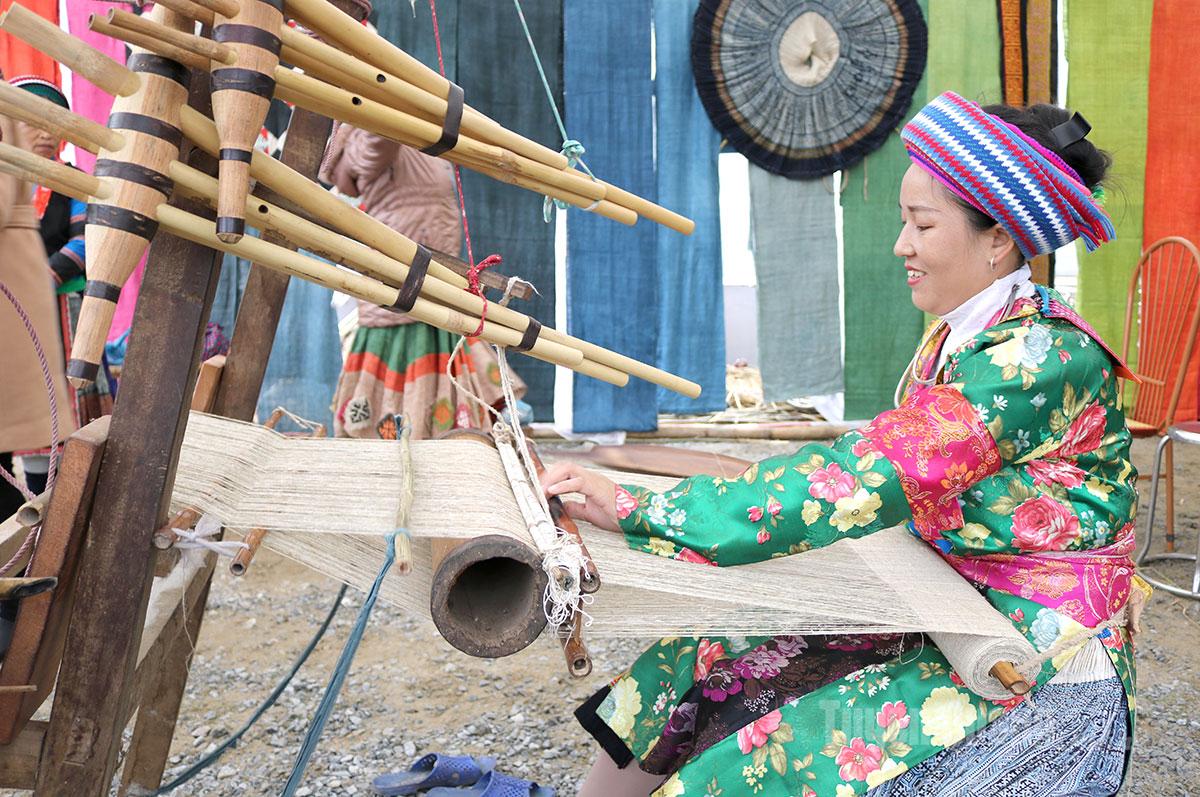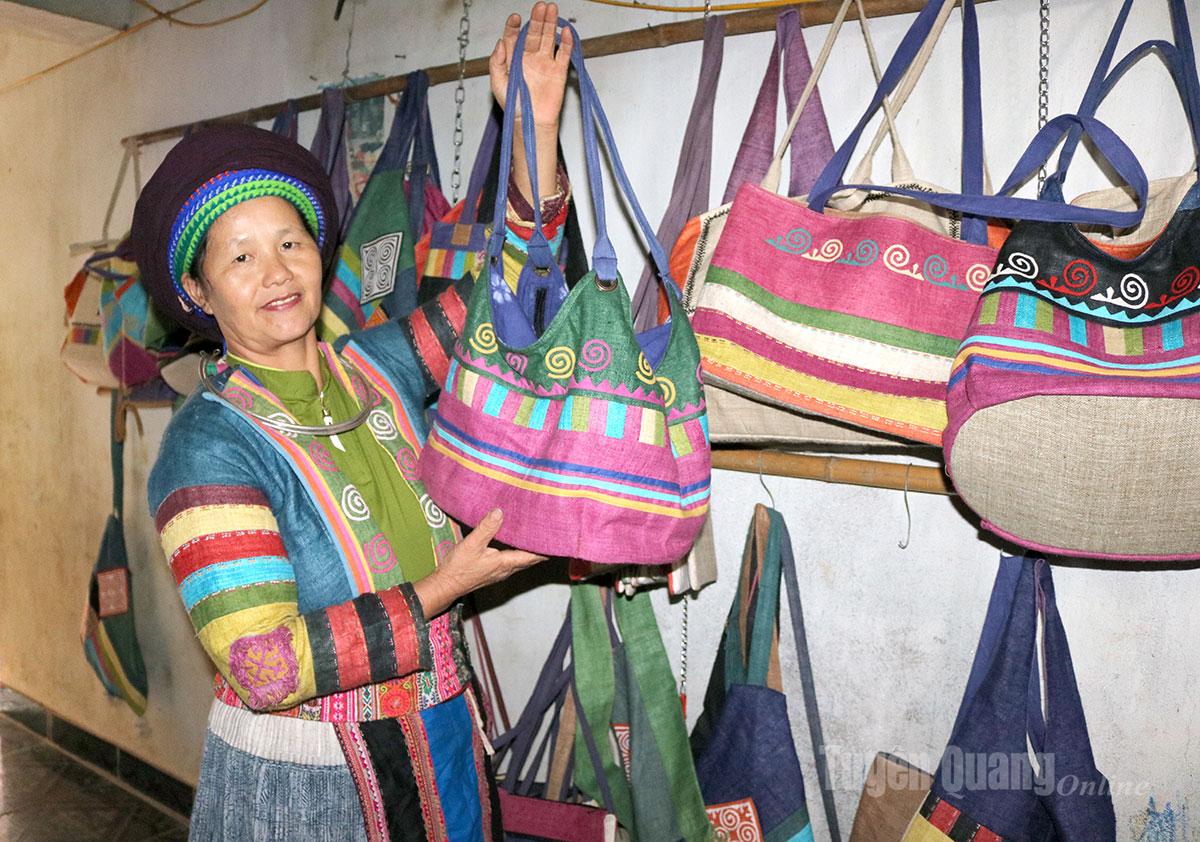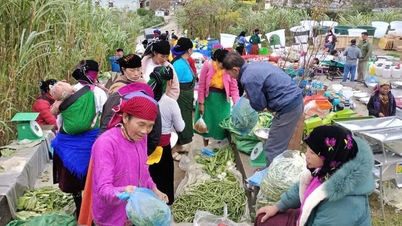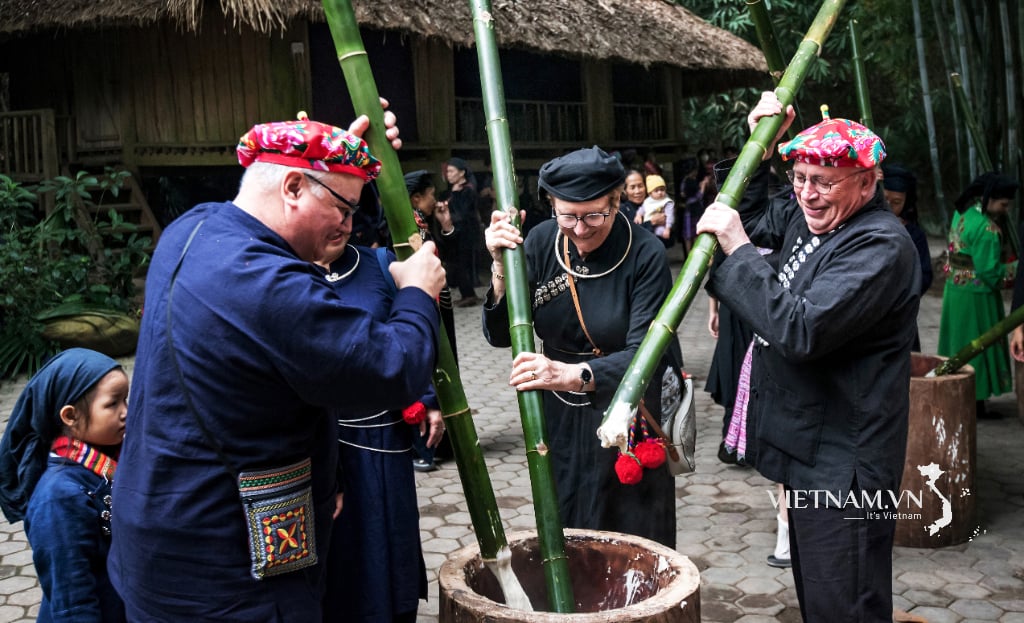Linen "weaves" dreams of self-reliance.
For centuries, linen weaving has been an important part of the Hmong people's lives, but today, the craft has transcended its traditional meaning. It's not only a way to preserve their unique cultural identity but also a key to unlocking gender equality for Hmong women. When their skillful hands transform raw linen fabrics into exquisite products like handbags, wallets, scarves, and home decor items, these not only captivate tourists but also provide a stable income. This allows them to become economically independent, assert their self-worth, and have a stronger voice in their families and society.
Hmong women weave traditional linen fabric. |
Right in front of the entrance to the King's mansion in Sa Phin commune, the showroom of the Sa Phin A Agricultural and Forestry General Service Cooperative (also known as the White Linen Cooperative), founded by Ms. Vang Thi Cau, is always bustling with visitors and shoppers. Ms. Cau is a living example of extraordinary resilience. Although born in 1973, she only officially started first grade in 1990 and graduated from university at the age of 40. After returning to her hometown to work and participate in women's affairs in the former Dong Van district, she came into contact with many women in difficult circumstances; being a local, she deeply understands the difficulties and disadvantages faced by Mong women.
She vividly remembers the story of Ms. Hau Thi Va in Pho Bang commune, who was frequently beaten by her husband, even having her leg broken once. Ms. Cau gave Ms. Va 500,000 VND to buy fertilizer and flax seeds to plant. A few months later, Ms. Va asked Ms. Cau to help sell the flax yarn. It was from this story that the idea of establishing the White Flax Cooperative began to take shape in her mind, with the desire to preserve the Mong cultural identity and provide employment for women like Ms. Va. Thanks to her educational background, she developed the organizational and management skills to establish the cooperative and had a vision for economic development for women.
With a loan from Program 135, she and 10 initial members started their business, and on November 23, 2017, the Lanh Trang Cooperative was officially established. To date, the cooperative has created stable jobs for 95 members in Sa Phin commune and many other communes in the surrounding area, producing more than 70 lines of handcrafted brocade products with a distinct Mong identity. The average income of members reaches 3-4.5 million VND/month, a dream figure for many families in the highlands.”
"The Lady of Linen" and her miraculous transformation.
Not only in Sa Phin, but linen is also quietly weaving similar stories of life transformation in Lung Tam commune, home to the "linen lady" Vang Thi Mai. Born in 1962, Ms. Mai has served as the Chairwoman of the Women's Association in Hop Tien village for nearly 20 years. From a Hmong woman who quietly wove linen in the corner of her kitchen, Ms. Mai has now become the Director of the Lung Tam Linen Cooperative, a renowned artisan both domestically and internationally, and is honored as the "Queen of Brocade".
Ms. Vang Thi Mai introduces products from the Lung Tam Linen Cooperative. |
In 2001, with the support of the local government, Ms. Mai established the Lung Tam Linen Cooperative with 10 members and an initial capital of 13 million VND. Recalling the early days, she faced countless difficulties: “When the cooperative was first established, the women were prevented from working by their husbands. Some were even slapped in the face by their drunken husbands while working, and dragged in front of me. Some were even beaten until they bled. I had to work with the commune's People's Committee and request the commune police to protect the women. Any man who got drunk and beat a woman would be taken to the police station and punished by having to carry stones and clean public restrooms.”
Ms. Mai expressed her concern: "I see how hard the Hmong women work, and we need to find a way to lift them out of this hardship and suffering. Men come home drunk, don't cook rice or feed the pigs, and force their wives to do everything. Sometimes, these drunken husbands throw bundles of flax into the street, saying, 'I married my wife only to serve at home and not to do any work outside.'"
To change the deeply ingrained mindset of the Hmong men, when the cooperative distributed product money, Ms. Mai had to personally go and talk to each husband, inviting them to participate in receiving the money and subtly suggesting they use it to repair their pigpens and chicken coops. Gradually, through persistence and tact, Ms. Mai managed to "win over" many of the cooperative members' husbands. They began to "realize" that their wives not only knew how to manage the household but also earned money to support their children's education and build houses that were no less impressive than theirs, or even better.
Ms. Mai not only changed the fate of flax but also the fate of Hmong women. She attracted poor, unemployed women, orphaned children, and skilled elderly people to teach her the craft. For each product sold, she allocates a portion to pay the artisans who teach the younger generation. To date, the cooperative's flax products have been exported throughout the country and to 20 international partners, mainly in the European market. Average annual revenue reaches approximately 1.5 billion VND with 140 members and 9 production groups. Members earn an average income of 4-6 million VND per month.
Comrade Mai Xuan Minh, Vice Chairman of the People's Committee of Lung Tam commune, affirmed: "The Lung Tam Linen Cooperative has significantly contributed to solving employment problems and increasing income for the people, always serving as a solid support for Mong women in the locality. Through this, gender equality is promoted, domestic violence is reduced, and women have a greater role and position in the family and society."
The traditional linen weaving craft of the Hmong people has helped women in the rocky plateau region affirm their self-worth, break down invisible barriers, and weave a brighter, more equal future for themselves and future generations.
Text and photos: Le Hai
Source: https://baotuyenquang.com.vn/xa-hoi/202507/phu-nu-dan-toc-mong-voi-nghe-det-lanh-truyen-thong-8eb6ee9/



















































































































Comment (0)